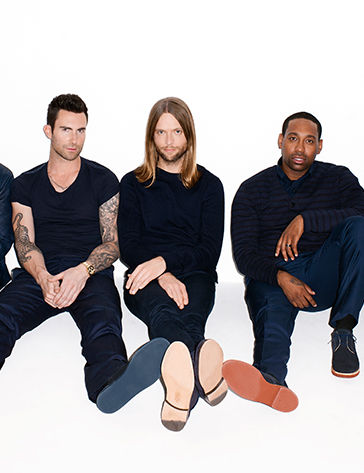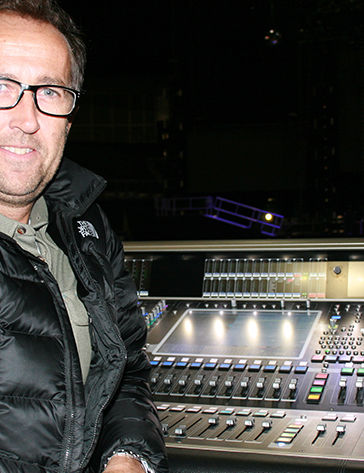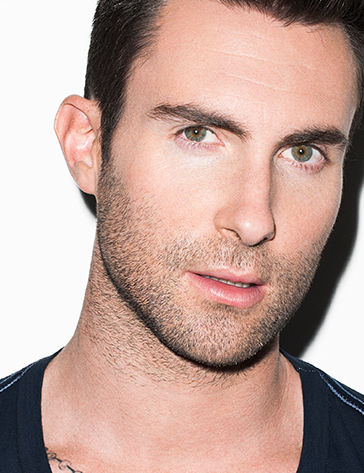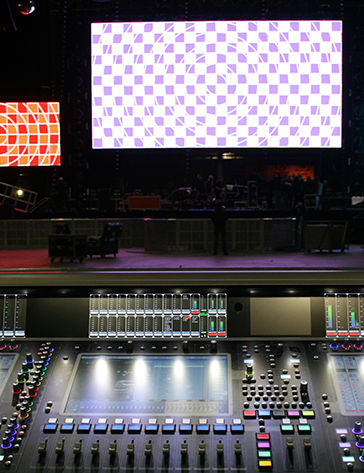Would you believe that Maroon 5’s debut, Songs About Jane, is now more than 10 years old? Even more staggering, perhaps, is that the band have been together for almost 20. That breakthrough record reached multi-platinum status internationally, and now, they’re selling out the world’s premiere venues, with frontman Adam Levine reaching new heights of fame after landing a judging role on the popular US version of The Voice. Has there ever been a better time to be working with Maroon 5? Headliner talks to Kevin Glendinning, who looks after monitor world, and FOH engineer, Jim Ebdon...
KEVIN GLENDINNING: IN-EAR ENGINEER
You’ve worked with the band for five years; have they all made the transition to in-ears? [smiles] Almost..! There’s only one that’s not. When I presented the idea to them, they could really see the benefits. We’re all mid- 30s now, and none of us want to have any ear damage. They were big wedge guys, but now it’s very much ‘less is more’: wedges, fills, speakers, and subs are all gradually vanishing from stage. At one point it was insane, and FOH was definitely affected; that’s not a slag on anyone that was there before us, but we have taken a differ- ent approach, certainly.
Would you agree that the band’s sound is more polished, now?
Yeah, a more produced sound these days, I think. They still jam, but we try to create a slickness, an organic feel, as it’s still a rock band out there. It’s beneficial for Jim [Ebdon] that we’ve tightened things up a little, so the onstage sound is a little quieter. It’s not just the monitoring side; we’ve put a lot of the guitar cabs off stage, eliminated some of the subs behind the drums, and the actual vol- umes out of the rigs. For example, there’s no longer a Leslie [speak- er], we have a simulator now. We’ve knocked things off gradually; it’s no good landing on Mars if you’re not used to it!
They’re a very musical bunch, right?
Absolutely, and that makes it easier for me, definitely. They’ve lit- erally played thousands of shows together, and they’re really great dudes; they ask what we think instead of saying, ‘we’ll do it this way’. I might say that the crack is off on the snare, or whatever, and they’ll be happy to change it. They definitely care, put it that way. So I came up with the idea of talking to JH Audio. I told the band I’d done a lot of research, and that this was the best solution, and they were fired up about it. We had an opportunity in New York to get all the guys’ fittings done with a lady called Julie Glick.
Which JH models are you using?
We’re on the JH13s. Jerry has the Roxanne now, which is killer, but at the time, I had other clients on JH16s, and thought they were too bass-driven for Maroon 5, as less is more with these guys. All the way down to the JH5 though, through to the JH7, 10, 13, and 16 - they all serve a purpose, whether it’s for an economical fit, or for musical style. I got Justin Timberlake on the JH16s about four years ago, as he is into the beat and dance feel; that would never cut it for Adam. I also got Alicia [Keys] on the JH13s, because she is all about vocal.
JIM EBDON: GREAT EXPECTATIONS
Your background is in making records; has that made you a better live mixer?
Definitely. It helps so much having the studio background. I remember when the big tape ma- chines were moving out, and drum machines were moving in, so I learned about those new tech- niques as well as the old ones. That’s had a great influence on my live sound. I remember when I was asked to leave school at 16 [laughs], I got a job working at Surrey Sound Studios, which is where The Police made all their records. I swept floors and made tea for 50 quid a week, and soon got the studio bug! I don’t mix records so much now, as it’s a different business; when studios started struggling, I moved into the live arena, and now I earn my living as a live sound engineer. I always thought I’d be a record producer and millionaire by the time I was 30. Funny, isn’t it?
Are you running your DiGiCo SD7 at 48kHz or 96kHz for Maroon 5?
I have one SD rack for the opening act and one for me, both running at 48kHz. Last year we did two tours, and the system all the way down to the amps was at 96kHz. There was a big argument as to which is better; I actually don’t think either is better or worse, it’s just about audio preference. I prefer 48kHz with the current setup as it’s easier to listen to over long periods.
You also use the Waves SoundGrid...
Yep, it’s all there in the console. I like all the Waves plugins, especially the SSL compressors, and all the Renaissance compressors and limiters. I used a lot of the hardware stuff in my studio days, and the plugins really are incredible replicas. I have my dongle in my pocket at all times!



